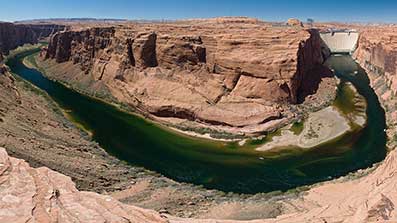By Gary Applebee
Last weekend, Sept. 26th, I went to a symposium for anglers on steelhead. It was held at the Aquarium of the Pacific in Long Beach. This symposium was put on by Trout Unlimited (TU), Caltrout, and Wild Steelheaders United and started at noon on the hottest day of the week. About fifty people showed up in a room by the Steelhead exhibit. Sandra Jacobson (Caltrout) and Sam Donaldson (TU) started off with an overview of what we would hear and see for the day. The Southern Steelhead was listed as Endangered in 1998. This day all the talks would be science based in language anglers could understand without getting bored.
First up was John McMillan from TU. He talked about the Steelhead Science: O.mykiss diversity and resiliency. He lives up on the Olympic Peninsula by the Hoh River and Sol Duc Rivers. The steelhead and the rainbow trout are the same species. No one can figure out why one goes to the ocean and the other stays home to become a resident trout. John talked about the behavior of steelhead when spawning. He also had a video of a six inch resident rainbow fertilizing the eggs by sneaking under two big males fighting over the female.
Then Mark Capelli from NOAA talked about the Endangered Steelhead and Recovery Plan Recovery. The Southern Steelhead starts up by the Santa Maria River and goes all the way to the Mexican border in the Tijuana River. There are 5 bio-geographical areas in this region. There are 22 million people in the area and since 1994 only 147 steelhead have been counted. Mark talked about the Santa Margarita River and the work going on there. He talked about barriers such as dams, culverts, storm drains, and others stopping steelhead from going to their spawning grounds.
Mary Larson from the CADFW talked about SoCal Trout Angling Opportunities and Regional Southern Steelhead Recovery Actions. Like reestablishing natural production, reestablishing a self-sustaining population of steelhead and enhancing angling opportunities and consumptive uses. The CADFW wants anglers to be able to fish for steelhead. Mary works on Habitat Assessment (conducts assessments, evaluate barriers and develop watersheds) and Watershed Restoration, which are (educate and outreach to communities, develop projects with land owners and municipalities, implement barrier removals and stream restorations). They get some money from Prop 1 that will be available for thirty years.
Sabrina Drill (University of California Cooperative Ext) talked about Southern California Steelhead Research and Monitoring: Coastal Salmonid Monitoring Program and Protocols. Sabrina was the one to tell us that since 1994 147 adult steelhead fish have been counted. There needs to be 4,150 for us to be able to fish for steelhead in southern California waters. This can take from 75 years to 100 years. The Southern California steelhead can tolerate water up to 25-28 degrees Celsius; 29 degrees Celsius is about 70 degrees. The Southern Steelhead is resilient and has to be to survive our summer temperatures and droughts (very low water in the streams).
Dana McCanne CADFW talked about Steelhead Monitoring and the Role of Native Rainbow Trout in Steelhead Recovery. Dana works with landowners to get access to monitor steelhead. As you can guess many don’t want to talk to him, some do. Dana talked to us about how holding a steelhead out of the water for a Grip and Grin photo affects the steelhead spawn. If I remember right, 3-10 seconds out of the water can stop a steelhead from spawning.
Drew Irby and George Sunderland (Steelhead United and TU South Coast Chapter) talked about how you should handle a big fish, be it a steelhead or other species of fish. There was talk of how to net a fish. How to set up for that Grip and Grin IF you have to have it. Like, get the camera set up with the fish in a net and ready to take the photo. Then a quick one, two, three count and lift the fish click the picture try for less than a second and back in the water. Underwater photos are the best. Keep the gills and fish wet. How a fish flopping on the bank can give the fish brain damage.
Check out the LA River blog, http://lariverflyfishing.com to read a better article about this event. I like his motto, “Fishing for carp, waiting for steelhead.”



